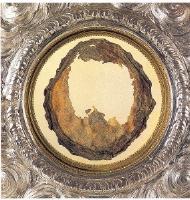Eighth Century in Lanciano
The eighth century saw many heresies arise regarding the faith, from both outside and inside the Catholic Church. Even priests and religious fell victim to heretical ideas, especially one concerning the Real Presence of Jesus in the Blessed Sacrament. One such Basilian monk was really struggling with his faith. Bit by bit the heresies of the day wore away at his faith and he prayed fervently to be relieved of his doubts. He feared he was losing his vocation. One particular morning, in a church at Lanciano, he was having a severe attack of doubt and as he consecrated the bread and wine he was completely overcome with shock that he could not stop shaking.
The bread and wine had turned into flesh and blood.

After a considerable time he turned to the gathered faithful. “O fortunate witnesses to whom the Blessed God, to confound my disbelief, has wished to reveal Himself in this Most Blessed Sacrament and to render Himself visible to our eyes. Come, brethren, and marvel at our God so close to us.’ he said.
“Behold the Flesh and Blood of our most beloved Christ.” The monk’s faith was restored and Lanciano soon became a site for pilgrims. Since then, however, the miracle continues – the flesh and blood are still reserved in reliqueries and have not decomposed as one would expect. Many scientific tests have been conducted on this Eucharistic Miracle, the most recent in 1970. The results are as follows:
- The flesh is real flesh. The blood is real blood.
- The flesh consists of the muscular tissue of the heart (myocardium)
- The flesh and blood belong to the human species.
- The flesh and blood have the same blood type (AB).
- In the blood, there were found proteins in the same normal proportions as are found in the seroproteic make up of fresh, normal blood.
- In the blood, there were also found these minerals: Chlorides, phosphorous, magnesium, potassium, sodium and calcium. The preservation of the flesh and of the blood, which were left in their natural state for twelve centuries (without any chemical preservatives) and exposed to the action of atmospheric and biological agents, remains an extraordinary phenomenon.
Thirteenth Century in Bolsena – Orvieto
Another Eucharistic miracle starts off with a priest, Peter of Prague, who was having doubts with his belief in the Real Presence. This disquiet were not aided by another Eucharistic heresy present at the time. The Bohemian priest decided to go on a pilgrimage to Rome to ask for his vocation to be strengthened and for his doubts to be removed. On his journey he stopped at a small town named Bolsena, near Rome, where he offered Mass. When it came time for the consecration, the host began to bleed.
He wrapped the host in the corporal, dripping some blood onto the marble tiles of the altar, and left to see Pope Urban IV, who was nearby in the town of Orvieto. Upon inspection of the host, the Holy Father immediately declared it a miracle which dispelled the current heresy. He also created a new feast, the Feast of Corpus Christi, in order to commemorate the miracle. St Thomas Aquinas wrote two hymns, O Salutaris and Tantum Ergo, especially for the feast. The bloodstained marble tiles are kept in Bolsena and the bloodstained Corporal in Orvieto and both remain popular pilgrimage sites today and I am blessed to have visited Orvieto whilst on pilgrimage in 2005 and have seen the Corporal with my own eyes.

Originally posted 2014-10-22 22:52:49.
